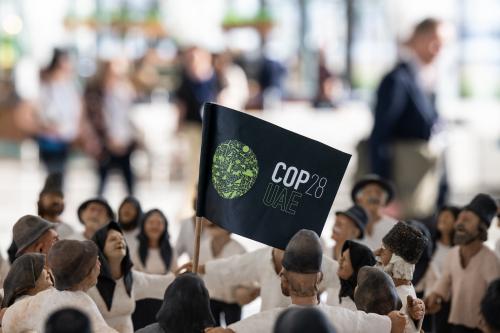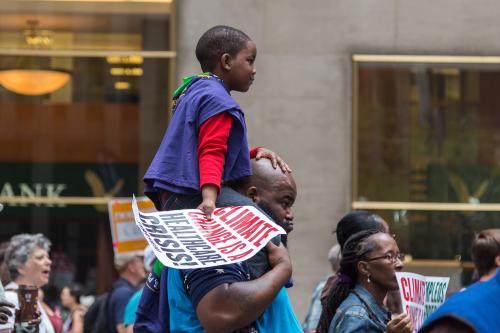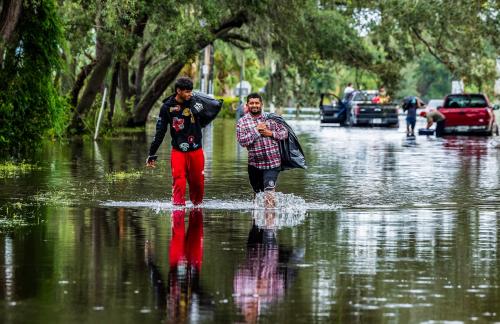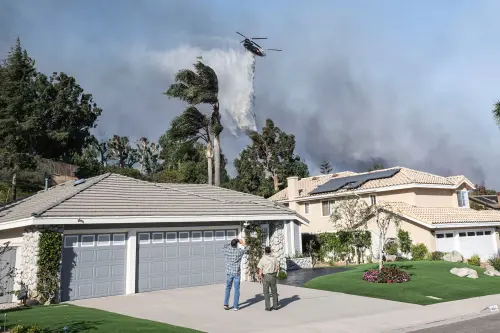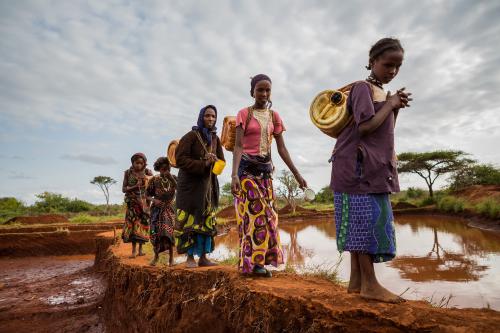When researchers, policymakers, and activists talk about climate, they are increasingly using terms such as “justice” and “equity.” These terms are now pervasive enough to appear in documents from groups as diverse as Extinction Rebellion, the United Nations, and Deloitte. But recent polling has found that relatively few Americans know what “climate justice” actually is.
With increasing claims of “greenwashing” directed at corporate America—and some state leaders fighting federal actions to advance climate justice—this Earth Day, it’s worth taking a closer look at climate and environmental justice (CEJ). When deployed in public policy and civic action, CEJ concepts can reveal the links between placed-based social injustices, climate impacts, and pollution, as well as offer pathways to inclusive and ultimately effective climate policy.
What is climate and environmental justice?
According to organizations such as the Intergovernmental Panel on Climate Change and Environmental Protection Agency (EPA), climate and environmental justice is about ensuring that all people and communities are provided the support, resources, and opportunities they need to thrive under an unstable climate. It means that individuals—regardless of race, ethnicity, income, gender, age, sexuality, ability, or location—can share in the benefits and opportunities created by climate and environmental policies, such as community investment, green jobs, and access to renewable energy. It also means that the unequal burdens of climate impacts and pollutants are minimized.
CEJ is closely related to the environmental justice movement, which Robert D. Bullard and others founded in the late 1980s and early 1990s after documenting highly unequal distributions of toxic pollutants across racial groups in the U.S. South. It’s deeply connected to concepts such as environmental racism and sacrifice zones, which attempt to identify how harmful developments are unfairly concentrated in majority-Black and other historically marginalized communities. It is also associated with movements such as that for climate reparations, which combine climate justice with racial justice, reparations, and decolonization movements.
In the most basic sense, CEJ is about the equitable distribution of costs and benefits between demographic groups, regions, occupations, and sectors. But achieving that equitable distribution often requires addressing the lingering legacies of policies rooted in structural racism, such as residential segregation. This means asking questions such as: Which groups are included in decisionmaking processes that affect local land use? Who’s at the table when the plans for a new development are drawn up? How have historic policies shaped the flow of capital and resources across groups and regions? Who has a stake in the ownership of public assets like electricity utilities?
These are important questions to ask, because the current pattern of climate impacts and vulnerabilities within the U.S. is highly inequitable. That’s not a moral claim, but a statement of fact. A plethora of studies demonstrate that communities of color are more likely to be located in areas with a lack of green space and parklands, hotter heat waves, less affordable electricity, and lower rates of compensation after climate-related disasters. These disparities mean that as the impacts of climate change intensify, they’re likely to drive a wedge in health, wealth, and well-being between demographic groups, thus worsening the existing gaps in these areas.
Climate and environmental justice gains in 2023 are shaping policy
After decades of pressure by activists and civic organizations, Americans are seeing the benefits of CEJ. Below are just a handful of highlights from 2023 that demonstrate how government agencies and civic organizations have applied CEJ approaches to advance more effective and equitable climate and environmental policy, from the local to international level.
Human- and civil-rights-based arguments have gained traction in litigation
In 2023, coalitions of activists, citizens, and academics used human- and civil-rights-based arguments to win environmental protections for some states and communities. These successes set precedents that can inform future litigation strategies. In August, a coalition of young Montanans sued their state, arguing that it had contravened their constitution by favoring the fossil fuel sector over the health of residents and the environment. While the U.S. has the highest rate of climate litigation internationally, few of these cases make it to trial. This was the first time a U.S. court declared that laws barring state agencies from considering the links between climate change and fossil fuel projects were unconstitutional.
In another U.S. first, the UN declared that the DuPont and Chemours factories in Fayetteville, N.C. violated international human rights by knowingly polluting the lower Cape Fear River Basin for decades with the “forever chemical” PFAS. The declaration came after a local citizens group—Clean Cape Fear, with the assistance of the University of California, Berkeley Environmental Law Clinic—filed a complaint with the UN accusing the companies of withholding toxicity data that clearly demonstrated disparate impacts on residents.
In the past, litigators have not been able to successfully use rights-based arguments; for example, the EPA has been burdened under legal challenges when they’ve attempted to enforce civil rights. Yet the above successes demonstrate a growing momentum around linking environmental injustices to human and civil rights.
The Biden administration’s CEJ policies are taking effect
Justice and equity have been a pillar of the Biden administration’s approach to climate and environment policies. Over 2023, these policies started to take effect in tangible ways. The Greenhouse Gas Reduction Fund, designed to enable low-income and historically marginalized communities to benefit from climate investments, has mobilized $14 billion to establish national clean financing institutions that provide affordable financing for energy projects in marginalized communities; issued $6 billion for technical assistance hubs that build capacity in communities for more effective climate infrastructure projects; and solicited notices of intent for $7 billion in solar investments in low-income and disadvantaged communities. Moreover, the EPA set stronger standards for local air quality, including soot pollution and methane emissions from the oil and gas sector, which are likely to directly improve the health of residents living alongside high-emitting industrial facilities.
The administration has also taken steps to embed CEJ across functions of government by releasing the National Climate Resilience Framework and establishing a White House Environmental Justice Advisory Council and Environmental Justice Interagency Council.
Disaster relief got an overhaul
After years of research showing failures in the ways that the Federal Emergency Management Agency (FEMA) distributes disaster relief (including our own research on the subject), the agency made extensive changes to their processes.
Many of these changes are likely to directly make disaster relief more equitable. One of the most notable—increasing the flexibility of individual assistance—will get relief to people sooner, provide displacement assistance, and automatically provide $750 for basic needs. Other changes, such as expanding eligibility for assistance and simplifying the notoriously complicated individual assistance application process, will reduce the barriers to accessing relief and get funds to more families quicker.
Chicago launched a bold plan to advance environmental justice
Chicago’s EJ Action Plan Report, released in December 2023, is perhaps the most comprehensive city plan yet in attempting to remedy historic environmental injustices. The report details a plan to target resources toward newly designated “environmental justice neighborhoods” identified in the city’s Cumulative Impact Assessment. These neighborhoods—representing roughly 30% of census tracts across the city—rank high in cancer-causing pollutants and diesel emissions, are proximate to industrial facilities, and have demographic factors associated with vulnerability, such as high asthma and heart disease rates, low incomes, high housing stress, and a high proportion of non-white residents.
The action plan’s proposals are far-ranging and practical, including updating zoning regulations to offer greater protections to over-polluted and marginalized communities; placing air quality monitors in these neighborhoods to improve the enforcement of pollution standards; and creating a fund to invest in amenities that improve residents’ long-term health and well-being. The city’s next step will be to enshrine the action plan into city ordinances later this year. This is no small task, and Chicago’s progress may set a new standard for municipal environmental justice policies.
The international community has moved closer to phasing out fossil fuels
While many in the CEJ community were rightly disappointed at the outcomes of COP28—the largest global forum to negotiate national commitments to take climate action—the final agreement was the first to agree to “transition” away from fossil fuels. The U.S. also pledged to support “largely” phasing out fossil fuels, signaling the administration’s movement toward formally adopting this stance.
Committing to phase out fossil fuels in the U.S. would not only help to mitigate climate impacts, but it would also directly benefit those living amid the industry’s local pollutants. A 2022 study estimated that nearly 14 million Americans across 236 counties lived in areas with an increased cancer risk because of air pollution emitted by oil and gas extraction. And even more Americans live alongside refineries and other industrial processes that are further down the oil and gas supply chain.
The decision to include the phrase “transition away from fossil fuels” in the COP28 agreement comes after sustained pressure on the international community from civic organizations and nations facing pronounced or existential climate threats. One example is the fossil fuel non-proliferation treaty—somewhat of a parallel to the nuclear non-proliferation treaty of 1970—which continues to gain influence. Several countries have agreed signed the treaty, including Colombia and Vanuatu, as have cities and subnational and civil society organizations. In the U.S., cities and states including California, Maine, and Austin, Texas have signed the treaty.
The CEJ movement has been focused on prevention—now it needs to shift toward building
In 2022, 71% of Americans said their community had experienced an extreme weather event. In this sense, climate impacts are an equalizer, with a unifying quality that crosses ideological, class, and racial divides. Yet current policy gaps and a history of unaddressed inequities mean that the threshold for a disaster is a lot lower for some households than others. These disparities turn climate change into a dividing force.
The actions and policies above show how CEJ can overcome these divisions by building new and more equitable policy structures. Pioneers of the CEJ movement developed its focus around prevention issues such as stopping high-polluting industrial developments in low-income neighborhoods. While prevention is still an important goal, the movement now needs to reorient toward building—creating new policies that embed justice and equity as measurable targets. This would include, for example, where and how governments distribute public funds to finance and build climate-resilient infrastructure.
By embracing this new approach, on future Earth Days the CEJ community might not only reflect on the environmental damage prevented, but also on the advancements made toward a more equitable future.
The Brookings Institution is committed to quality, independence, and impact.
We are supported by a diverse array of funders. In line with our values and policies, each Brookings publication represents the sole views of its author(s).



